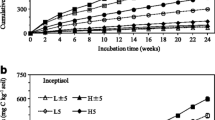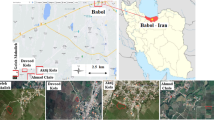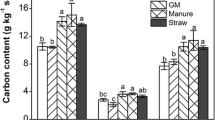Abstract
Purpose
The objective of the present study was to explore the effect of initial pH on the decomposition rate of plant residues and the effect of residue type on soil pH change in three different paddy soils.
Materials and methods
Two variable charge paddy soils (Psammaquent soil and Plinthudult soil) and one constant charge paddy soil (Paleudalfs soil) were used to be incubated at 45 % of field capacity for 105 days at 25 °C in the dark after three plant residues (Chinese milk vetch, wheat straw, and rice straw) were separately added at a level of 12 g kg−1 soil. Soil pH, CO2 escaped, DOC, DON, MBC, MBN, NH +4 , and NO −3 during the incubation period were dynamically determined.
Results and discussion
Addition of the residues increased soil pH by 0.1–0.8 U, and pH reached a maximum in the Psammaquent and Plinthudult soils with low initial pH at day 105 but at day 3 in the Paleudalfs soil with high initial pH. Incorporation of Chinese milk vetch which had higher concentration of alkalinity (excess cations) and nitrogen increased soil pH more as compared with incorporation of rice and wheat straws. Microbial activity was the highest in Chinese milk vetch treatment, which resulted in the highest increase of soil pH as compared with addition of rice and wheat straws. However, nitrification seemed to be inhibited in the variable charge soils of Psammaquent and Plinthudult but not in the constant charge soil of Paleudalfs.
Conclusions
The effectiveness of increasing soil pH after incorporation of the plant materials would be longer in low initial pH soils of Psammaquent and Plinthudult than in high initial pH soil of Paleudalfs. In order to achieve the same degree of pH improvement, higher amounts of plant residues should be applied in constant charge soils than in variable charge soils.







Similar content being viewed by others
References
Anderson TH (1998) The influence of acid irrigation and liming on the soil microbial biomass in a Norway spruce (Picea abies [L.] K.) stand. Plant Soil 199:117–122
Andersson S, Nilsson I, Saetre P (2000) Leaching of dissolved organic carbon (DOC) and dissolved organic nitrogen (DON) in mor humus as affected by temperature and pH. Soil Biol Biochem 32:1–10
Bååth E, Anderson TH (2003) Comparison of soil fungal/bacterial ratios in a pH gradient using physiological and PLFA-based techniques. Soil Biol Biochem 35:955–963
Bessho T, Bell LC (1992) Soil solid and solution phase changes and mung bean response during amelioration of alumunium toxicity with organic matter. Plant Soil 140:183–196
Bolan NS, Hedley MJ, White RE (1991) Processes of soil acidification during nitrogen cycling with emphasis on legume based pastures. Plant Soil 134:53–63
Broadbent FE (1947) Nitrogen release and carbon loss from soil organic matter during decomposition of added plant residues. Soil Sci Soc Am J 12:246–249
Broadbent FE, Nakashima T (1974) Mineralization of carbon and nitrogen in soil amended with carbon-13 and nitrogen-15 labeled plant material. Soil Sci Soc Am J 38:313–315
Butterly CR, Baldock JA, Xu JM, Tang CX (2009) Is the alkalinity withn agricultural residues soluble. In: Xu JM, Huang PM (eds) Molecular environmental soil science at the interfaces in the earth’s critical zone. Zhejiang University Press, Zhejiang, pp 314–316
Butterly CR, Bhatta Kaudal B, Baldock JA, Tang C (2011) Contribution of soluble and insoluble fractions of agricultural residues to short-term pH changes. Eur J Soil Sci 62:718–727
Duong TTT, Baumann K, Marschner P (2009) Frequent addition of wheat straw residues to soil enhances carbon mineralization rate. Soil Biol Biochem 41:1475–1482
Fontaine S, Mariotti A, Abbadie L (2003) The priming effect of organic matter: a question of microbial competition? Soil Biol Biochem 35:837–843
Haynes RJ, Mokolobate MS (2001) Amelioration of Al toxicity and P deficiency in acid soils by addition of organic residues: a critical review of the phenomenon and the mechanisms involved. Nutr Cycl Agroecosys 59:47–63
Helyar KR (1976) Nitrogen cycle and soil acidification. J Austr Inst Agr Sci 42:217–221
Helyar KR, Porter WM (1989) Soil acidification, its measurement and the processes involved. In: Robson AD (ed) Soil acidity and plant growth. Academic, Sydney, pp 61–100
Herrick JE, Wander MM (1997) Relationship between soil organic carbon and soil quality in cropped and rangeland soils: the importance of distribution, composition, and soil biological activity. In: Lal R, Kimble JM, Follett RF, Stewart BA (eds) Soil processes and the carbon cycle conference paper, pp 405–425
Hoyt PB, Turner RC (1975) Effects of organic materials added to very acid soils on pH, aluminum, exchangeable NH4, and crop yield. Soil Sci 119:227–237
Jarvis SC, Stockdale EA, Shepherd MA, Powlson DS (1996) Nitrogen mineralization in temperate agricultural soils: processes and measurements. Adv Agron 57:187–235
Löhnis F (1926) Nitrogen availability of green manures. Soil Sci 22:253–290
Lu RK (2000) Soil agro-chemistry analysis. Agricultural Technical Press of China, Beijing
Marschner B, Noble AD (2000) Chemical and biological processes leading to the neutralisation of acidity in soil incubated with litter materials. Soil Biol Biochem 32:805–813
Marstorp H, Guan X, Gong P (2000) Relationship between dsDNA, chloroform labile C and ergosterol in soils of different organic matter contents and pH. Soil Biol Biochem 32:879–882
Mary B, Recous S, Darwis D, Robin D (1996) Interactions between decomposition of plant residues and nitrogen cycling in soil. Plant Soil 181:71–82
Noble AD, Randall PJ (1999) Alkalinity effects of different tree litters incubated in an acid soil of N.S.W., Australia. Agroforestry Syst 46:147–160
Noble AD, Zenneck I, Randall PJ (1996) Leaf litter ash alkalinity and neutralisation of soil acidity. Plant Soil 179:293–302
Paul KI, Black AS, Conyers MK (2001) Influence of fallow, wheat and subterranean clover on pH within an initially mixed surface soil in the field. Soil Biol Biochem 33:41–52
Pocknee S, Sumner ME (1997) Cation and nitrogen contents of organic matter determine its soil liming potential. Soil Sci Soc Am J 61:86–92
Poss R, Smith CJ, Dunin FX, Angus JF (1995) Rate of soil acidification under wheat in a semi-arid environment. Plant Soil 177:85–100
Robson AD, Abbot LK (1989) The effect of soil acidity on microbial activity in soils. In: Robson AD (ed) Handbook of soil acidity and plant growth. Academic, Sydney, pp 139–165
Sandra F, Joann KW, Myrna J, Simpson H, Henry J (2011) Plant lignin and nitrogen contents control carbon dioxide production and nitrogen mineralization in soils incubated with Bt and non-Bt corn residues. Soil Biol Biochem 43:63–69
Tang QY, Feng MG (2007) DPS data processing system: experimental design, statistical analysis, and data mining. Science Press, Beijing
Tang C, Rengel Z (2003) Role of plant cation/anion uptake ratio in soil acidification. In: Rengel Z (ed) Handbook of soil acidity. Marcel Dekker, New York, pp 57–81
Tang C, Yu Q (1999) Impact of chemical composition of legume residues and initial soil pH on pH change of a soil after residue incorporation. Plant Soil 215:29–38
Tang C, McLay CDA, Barton L (1997) A comparison of the potential proton excretion of twelve pasture legumes grown in nutrient solution. Aust J Exp Agr 37:563–570
Tang C, Sparling GP, McLay CDA, Raphael C (1999) Effect of short-term legume residue decomposition on soil acidity. Aust J Soil Res 37:561–573
Vance ED, Brookes PC, Jenkinson DC (1987) An extraction method for measuring soil microbial biomass C. Soil Biol Biochem 19:703–707
van Veen JA, Kuikman PJ (1990) Soil structural aspects of decomposition of organic matter by microorganisms. Biogeochemistry 11:213–233
Wada K (1989) Allophane and imogolite. In: Dixon JB, Weed SB (eds) Minerals in soil environments, 2nd edn. Soil Science Society of America, Madison, pp 1051–1087
Wardle DA (1992) A comparative assessment of factors which influence microbial biomass carbon and nitrogen levels in soil. Biol Rev 67:321–358
Wu J, Brookes PC, Jenkinson DS (1993) Formation and destruction of microbial biomass during the decomposition of glucose and ryegrass in soil. Soil Biol Biochem 25:1435–1441
Xu RK, Coventry DR (2003) Soil pH changes associated with lupin and wheat plant materials incorporated in a red-brown earth soil. Plant Soil 250:113–119
Xu JM, Tang C, Chen ZL (2006a) The role of plant residues in pH change of acid soils differing in initial pH. Soil Biol Biochem 38:709–719
Xu JM, Tang C, Chen ZL (2006b) Chemical composition controls residue decomposition in soils differing in initial pH. Soil Biol Biochem 38:544–522
Yan F, Schubert S (2000) Soil pH changes after application of plant shoot materials of faba bean and wheat. Plant Soil 220:279–287
Yan F, Schubert S, Mengel K (1996) Soil pH increase due to biological decarboxylation of organic anions. Soil Biol Biochem 28:17–24
Yao H, Xu J, Huang C (2003) Substrate utilization pattern, biomass and activity of microbial communities in a sequence of heavy metal-polluted paddy soils. Geoderma 115:139–148
Zelles L (1999) Fatty acid patterns of phospholipids and lipopolysaccharides in the characterisation of microbial communities in soil: a review. Biol Fertil Soils 29:111–129
Acknowledgments
This work was financially supported by the National Basic Research Program of China (2011CB100502), National Science and Technology Support Program (2012BAD15B04), the Special Fund for Agro-scientific Research in the Public Interest (201003016), and the Australian Research Council (Discovery Project DP0877882). The authors gratefully acknowledge Professor Phillip C Brooks from Rothamsted Research, UK for his valuable suggestions and contribution to the language and syntax revise of this article.
Author information
Authors and Affiliations
Corresponding authors
Additional information
Responsible editor: Weixin Cheng
Rights and permissions
About this article
Cite this article
Wang, Y., Tang, C., Wu, J. et al. Impact of organic matter addition on pH change of paddy soils. J Soils Sediments 13, 12–23 (2013). https://doi.org/10.1007/s11368-012-0578-x
Received:
Accepted:
Published:
Issue Date:
DOI: https://doi.org/10.1007/s11368-012-0578-x




